Why Wood Floors are Great for People with Allergies
Posted by Aaron Schaalma

Posted by Aaron Schaalma

Learn what truly dustless hardwood refinishing means, key signs of a clean setup, process steps, and how to choose the right Wisconsin pro.
Posted
By Aaron Schaalma

Protect your wood floors with the right cleaner. Learn how to choose safe, pH-neutral options that enhance beauty, prevent damage, and extend life
Posted
By Aaron Schaalma

Refinishing wood floors restores their shine, protects against damage, and enhances home value—revive your space with lasting beauty and style.
Posted
By Aaron Schaalma